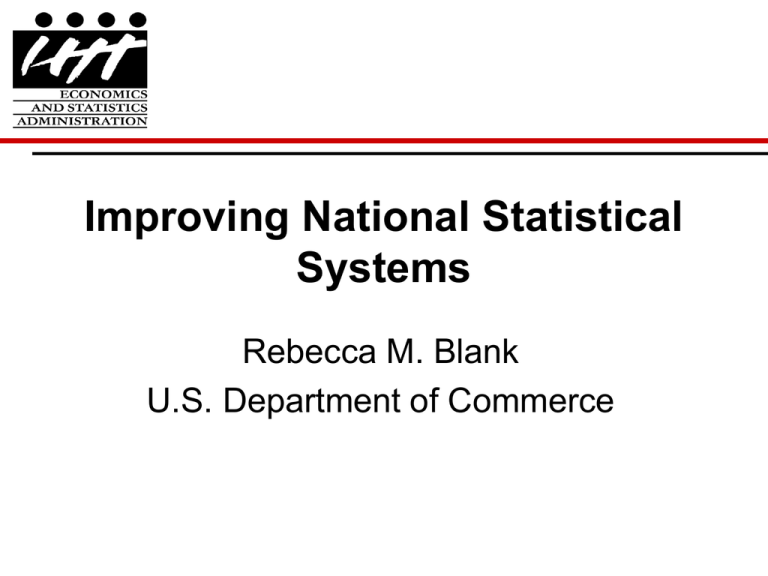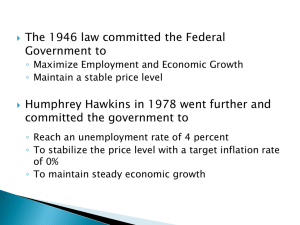Improving National Statistical Systems Rebecca M. Blank U.S. Department of Commerce
advertisement

Improving National Statistical Systems Rebecca M. Blank U.S. Department of Commerce Recent news has been bad • International financial system came close to collapse • Unemployment has risen sharply • Output has fallen All of this was unexpected GDP Forecasts for 2008 Forecasts as of Dec. 2007; year-over-year percent change 3 3 2 2 1 1 0 0 -1 -1 -2 -3 Average of IMF, OECD, Consensus Canada France Germany Japan UK Actual US -2 -3 GDP Forecasts for 2009 Forecasts as of Dec. 2008; year-over-year percent change 0 0 -1 -1 -2 -2 -3 -3 -4 -4 -5 -5 -6 Average of IMF, OECD, Consensus Canada* France Germany Japan * Based on first three quarters. Actual UK US -6 Key question Can we (those of us responsible for economic data) do better? Could we have provided better data that would have foreshadowed these economic problems or that would have allowed us to better understand the crisis as we were in the midst of it? Important Note Data problems did not cause this recession • The question is not: “Could we have reported better economic information? • BUT… “Could we have done a better job of reporting economic information?” My Focus Five U.S. examples: • Financial transactions • Credit information • Household wealth holdings • Industry information • Longitudinal information Session title: “Are National Statistical Systems Effective?” Answer to this is an unequivocal ‘yes’ They are good and getting better (and more coordinated across countries) all the time. But all systems can be improved. Example 1: Financial Transactions This recession was generated by near-collapse in the global financial sector, in part due to bad debt, much of it originating in the U.S. housing market. This financial crisis had many causes • Over-optimistic investors • Under-regulation by government • Lack of due diligence by private sector But even once we knew there was a problem, it was difficult to use existing data to understand it. Flow of funds data categories too aggregated. Within the U.S. we couldn’t tell which sectors held the bad debt or how much of it they held. And we couldn’t track it across national boundaries. Possible Improvements • More detail on the types of instruments that are held • More detail on the institutions that are issuing those instruments • Information on new issues and retirements of debt, as well as net flows • Better ability to track this information across countries Example 2: Credit Information Financial collapse created a credit crisis: Banks unwilling to make new loans until greater economic stability Once recovery started, this led to substantial concern about credit constraints. But it’s been very difficult to tell whether there are credit constraints and who they are affecting. Need to Separate Demand and Supply for Credit Little information on this: • In U.S., best data is a regular survey of senior loan officers, asking for their judgment about credit supply versus credit demand. • Most of our data just shows aggregate credit flows. Net Borrowing by Households Billions of dollars, annual rate 1,500 1,500 Mortgages 1,000 1,000 500 500 0 0 Consumer credit -500 2005 2007 2009 -500 Shading indicate recessions; end of recession is assumed to be July. Potential Improvements • Credit applications by type of applicant • Approvals by type of applicant • Alternative sources of credit that are used if formal financial institutions are not lending. Example 3: Household Wealth Recession led to large declines in assets and wealth. Potential effects: • Later retirement and higher labor force participation among older workers • Less investment in children • Reduced income among those who rely on pension investments Timely wealth data is limited Annual U.S. information comes from the Flow of Funds accounts, showing only aggregate information on wealth holdings among all households Household wealth survey occurs only once every three years. Last done in 2007. Household Net Worth Trillions of nominal dollars, year-end 80 80 Homeowners' equity Deposits Tangible assets Stocks, bonds, & other financial assets 60 60 40 40 20 20 0 0 1998 1999 2000 2001 2002 2003 2004 2005 2006 2007 2008 2009 Federal Reserve, Flow of funds 2009 is third quarter Possible Improvements • Higher-frequency household-level data on wealth collections • Distributional information in more aggregate data. Example 4: Industry-level detail • The recession has had a big negative effect on output, but some sectors have been hit harder than others. • Useful data would let us see how different sectors are doing in a timely manner. Manufacturing Output Index 2000 = 100 110 110 105 105 100 100 Annual Quarterly 95 95 90 90 85 2000 2001 2002 2003 2004 2005 2006 2007 2008 2009 Shading represents recession. End of latest recession assumed to be July. 85 Potential Improvements • Quarterly Industry GDP statistics • BEA has this in the current budget request to Congress. Example 5: Longitudinal Data Longitudinal firm-level data can: • Look at firm births and deaths over the economic cycle • Look at which firms contract (or grow) more than others in a time of economic change Longitudinal household-level data can: • Show what happens to families when one member experiences unemployment • Study unemployment spells • Investigate how changes in the housing market change family behavior over time Conclusions Gaps in knowledge occur when data more aggregated. Ways to disaggregate: • • • • With higher frequency data With more detailed categories of existing data With more micro-level information With more observations on the same unit over time Conclusions Resources are limited, so this is not a plea for “let’s do it all.” Data gaps need to be prioritized. But let’s use this crisis: • Seek gaps in the data we collect that would have helped us to better understand the effects of rapid economic change • Use this moment to argue for the additional resources needed to fill those gaps Conclusions • The purpose of the national data is to provide information. It is exactly in times of rapid change that the need for new and additional information is most visible. • May this be a moment of opportunity to improve statistical systems so they will be even more helpful in the next economic cycle.







